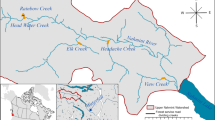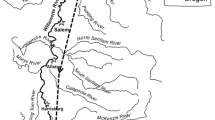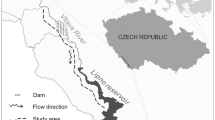Abstract
The resilience of aquatic ecosystems hinges on our ability to protect the native species that reside within them. The river redhorse (Moxostoma carinatum) is one such example and populations have become low enough to warrant a threatened status by the State of Michigan. An insufficient understanding of the species’ habitat use outside of its spawning season hinders the ability of fisheries managers to implement appropriate habitat protection and restoration measures. To enhance our understanding of river redhorse habitat use, we implanted 15 individuals with radio transmitters during the spring spawning run and tracked their locations over the course of a summer. River redhorse movement varied greatly with some individuals remaining within the spawning area throughout the summer and others traveling as far as 50 km down river. Once post-spawn movement ceased, river redhorse established themselves in small home ranges between 0.04 and 0.12 km2. We found no obvious selection for depth, sediment type, macrophyte presence, or water velocity. Instead, river redhorse strongly selected for habitat containing freshwater mollusks, the primary food source for the species. This suggests that they were seeking foraging habitat during this time period. These findings provide insight into river redhorse management, indicating that the recovery of the species may depend on our ability to protect these newly discovered feeding areas. Future river redhorse management efforts should therefore focus on the protection of native mussels and snails and the maintenance of migration routes between spawning and summer habitats.





Similar content being viewed by others
Availability of data and materials
The data that support the findings are available in GVSU’s Scholar Works at https://scholarworks.gvsu.edu/theses/942/
References
Aebischer NJ, Robertson PA, Kenward RE (1993) Compositional analysis of habitat use from animal radio-tracking data. Ecology 74(5):1313
Aldridge DC, Fayle TM, Jackson N (2007) Freshwater mussel abundance predicts biodiversity in UK lowland rivers. Aquat Conserv Mar Freshw Ecosyst 17(6):554–564. https://doi.org/10.1002/aqc.815
Alldredge JR, Ratti JT (1992) Further comparison of some statistical techniques for analysis of resource selection. J Wildl Manag 56(1):1–9. https://about.jstor.org/terms
Allen DC, Vaughn CC (2010) Complex hydraulic and substrate variables limit freshwater mussel species richness and abundance. J N Am Benthol Soc 29(2):383–394. https://doi.org/10.1899/09-024.1
Angermeier PL, Winston MR (1999) Characterizing fish community diversity across Virginia landscapes: prerequisite for conservation. Ecol Appl 9(1):335–349
Arbuckle KE, Downing JA (2002) Freshwater mussel abundance and species richness: GIS relationships with watershed land use and geology. Can J Fish Aquat Sci 59(2):310–316. https://doi.org/10.1139/f02-006
Becker GC (1983) River redhorse. Fishes of Wisconsin. University of Wisconsin Press, Madison, pp 674–677
Beckman DW, Hutson CA (2012) Validation of aging techniques and growth of the river redhorse, Moxostoma carinatum, in the James River, Missouri. Southwest Nat 57:240–247. https://doi.org/10.2307/23258010
Brown RS, Cooke SJ, Anderson WG, McKinley RS (1999) Evidence to challenge the “2% Rule” for biotelemetry. N Am J Fish Manag 19(3):867–871. https://doi.org/10.1577/1548-8675(1999)019%3c0867:ETCTRF%3e2.0.CO;2
Butler SE, Wahl DH (2017) Movements and habitat use of river redhorse (Moxostoma carinatum) in the Kankakee River, Illinois. Copeia 105(4):734–742. https://doi.org/10.1643/CE-17-626
Campbell BG (2002) A study of the river redhorse, Moxostoma carinatum (Pisces; Catostomidae), in the tributaries of the Ottawa River, near Canada’s National Capital and in a tributary of Lake Ontario, the Grand River, near Cayuga, Ontario. University of Ottawa Theses. https://doi.org/10.20381/RUOR-11104
Core Team R (2016) R: a language and environment for statistical computing. R Foundation for Statistical Computing, Vienna. https://www.r-project.org/
French JRP (1993) How well can fishes prey on zebra mussels in eastern North America? Fisheries 18(6):13–19. https://doi.org/10.1577/1548-8446(1993)018%3c0013:HWCFPO%3e2.0.CO;2
Haag WR, Williams JD (2014) Biodiversity on the brink: an assessment of conservation strategies for North American freshwater mussels. Hydrobiologia 735(1):45–60. https://doi.org/10.1007/s10750-013-1524-7
Hackney PA, Tatum WM, Spencer SL (1968) Life history study of the river redhorse, M. carinatum (Cope) in the Cahaba River, AL, with notes on the management of the species as a sport fish. Proc Southeast Assoc Game Fish Commis 21:324–332
Hall JW, Smith TIJ, Lamprecht SD (1991) Movements and habitats of shortnose sturgeon, Acipenser brevirostrum in the Savannah River. Copeia 1991(3):695. https://doi.org/10.2307/1446395
Halpern BS, Silliman BR, Olden JD, Bruno JP, Bertness MD (2007) Incorporating positive interactions in aquatic restoration and conservation. Front Ecol Environ 5(3):153–160
Hanshue SK, Harrington AH (2017) Grand River assessment. www.michigan.gov/dnr/
Hardison BS, Layzer JB (2001) Relations between complex hydraulics and the localized distribution of mussels in three regulated rivers. Regul Rivers Res Manag 17(1):77–84. https://doi.org/10.1002/1099-1646(200101/02)17:1%3c77::AID-RRR604%3e3.0.CO;2-S
Hastie LC, Boon PJ, Young MR (2000) Physical microhabitat requirements of freshwater pearl mussels, Margaritifera margaritifera (L.). Hydrobiologia 429(1/3):59–71. https://doi.org/10.1023/A:1004068412666
Michigan Natural Features Inventory (2007) Moxostoma carinatum River Redhorse. Rare Species Explorer (Web Application). https://mnfi.anr.msu.edu/abstracts/zoology/Moxostoma_carinatum.pdf
IUCN (2019) The IUCN red list of threatened species. http://www.iucnredlist.org. Accessed 2 Apr 2019
Jenkins RE (1970) Systematic studies of the catostomid fish tribe Moxostomatini. Doctoral Dissertation
Jepsen N, Koed A, Thorstad EB, Baras E (2002) Surgical implantation of telemetry transmitters in fish: how much have we learned? In: Aquatic telemetry. Springer Netherlands, Dordrecht, pp 239–248. https://doi.org/10.1007/978-94-017-0771-8_28
Lamothe K, Dextrase A, Drake A (2019) Aggregation of two imperfectly detected imperilled freshwater fishers: understanding community structure and co-occurrence for multispecies conservation. Endanger Species Res 40:123–132. https://doi.org/10.3354/esr00982
Lee D, Gilbert CR, Hocutt CH, Jenkins RE, McAllister DE, Stauffer JR (1980) Atlas of North American freshwater fishes, 12th edn. North Carolina Biological Survey, Raleigh, North Carolina
Marcum CL, Loftsgaarden DO (1980) A nonmapping technique for studying habitat preferences. J Wildl Manag 44(4):963. https://doi.org/10.2307/3808336
Mongeau J-R, Dumont P, Cloutier L (1992) La biologie du suceur cuivré (Moxostoma hubbsi) comparée à celle de quatre autres espèces de Moxostoma (M. anisurum, M. carinatum, M. macrolepidotum, M. valenciennesi). Can J Zool 70(7):1354–1363. https://doi.org/10.1139/z92-191
Mueller G, Marsh PC, Knowles G, Wolters T (2000) Distribution, movements, and habitat use of razorback sucker (Xyrauchen texanus) in a lower Colorado River reservoir, Arizona-Nevada. West N Am Nat 60(2):7. https://scholarsarchive.byu.edu/cgi/viewcontent.cgi?article=1156&context=wnan
Mulcrone RS, Rathbun JE (2018) Pocket field guide to the freshwater mussels of Michigan. Michigan Department of Natural Resources
NatureServe (2018) Comprehensive report species—Moxostoma carinatum. http://explorer.natureserve.org/explorer/. Accessed 19 Nov 2018
O'Keefe D (2002) Range expansion of the river redhorse (Moxostoma carinatum) in michigan. Proj Completion Rep, Nat Heritage Grant Program
Parker BJ (1988) Status of the river redhorse, Moxostoma carinatum, in Canada. Can Field Nat 102:140–146
Pikitch EK, Santora C, Babcock EA, Bakun A, Bonfil R, Conover DO, Sainsbury KJ et al (2004) Ecosystem-based fishery management. Science. https://doi.org/10.1126/science.1098222
Reid SM (2003) River redhorse (Moxostoma carinatum) and channel darter (Percina copelandi) populations along the Trent-Severn waterway. Parks Research Forum of Ontario. Peterborough. http://casiopa.mediamouse.ca/wp-content/uploads/2010/05/PRFO-2005-Proceedings-p221-230-Reid.pdf
Reid SM, Gignac H, Mandrak NE, Vachon N, Dumont P (2006) Assessment and update status report on the river redhorse. Committee on the Status of Endangered Wildlife in Canada, pp 3–30. https://www.registrelep-sararegistry.gc.ca/virtual_sara/files/cosewic/sr_river_redhorse_e.pdf
Reynolds JD, Dulvy NK, Roberts CM (2008) Exploitation and other threats to fish conservation. In: Handbook of fish biology and fisheries, vol 2. Blackwell Science Ltd, Oxford, pp 319–341. https://doi.org/10.1002/9780470693919.ch15
Ricciardi A, Rasmussen JB (1999) Extinction rates of North American freshwater fauna. Conserv Biol 13(5):1220–1222. https://doi.org/10.1046/J.1523-1739.1999.98380.X
Ross MJ, Kleiner CF (1982) Shielded-needle technique for surgically implanting radio-frequency transmitters in fish. Progres Fish Cult 44(1):41–43. https://doi.org/10.1577/1548-8659(1982)44[41:STFSIR]2.0.CO;2
Schlosser IJ (1991) Stream fish ecology: a landscape perspective. BioScience 41(10):704–712. https://www.jstor.org/stable/pdf/1311765.pdf?refreqid=excelsior%3A6b54455418354adb515bb56f601b411f
Scott WB, Crossman EJ (1973) Freshwater fishes of Canada. Fisheries Research Board of Canada, Ottawa
Stanford JA, Ward JV (1993) An ecosystem perspective of alluvial rivers: connectivity and the hyporheic corridor. J N Am Benthol Soc 12(1):48–60. https://doi.org/10.2307/1467685
Strayer DL (2014) Understanding how nutrient cycles and freshwater mussels (Unionoida) affect one another. Hydrobiologia 735(1):277–292. https://doi.org/10.1007/s10750-013-1461-5
Trautman MB (1981) Discovery of the river redhorse, Moxostoma carinatum, in the Grand River, an Ohio tributary to Lake Erie. Ohio J Sci 81:45–46. http://hdl.handle.net/1811/22757
USGS (2019) Temperature gauge 04119400 near Eastmanville, MI, provisional data. https://nwis.waterdata.usgs.gov/nwis/uv?. Accessed 28 Mar 2019
Vaughn CC, Nichols SJ, Spooner DE (2008) Community and foodweb ecology of freshwater mussels. J N Am Benthol Soc 27(2):409–423. https://doi.org/10.1899/07-058.1
Ward JV (1989) The four-dimensional nature of lotic ecosystems. J N Am Benthol Soc 8(1):2–8. https://doi.org/10.2307/1467397
Wenger SJ, Isaak DJ, Luce CH, Neville HM, Fausch KD, Dunham JB, Williams JE et al (2011) Flow regime, temperature, and biotic interactions drive differential declines of trout species under climate change. Proc Natl Acad Sci 108(34):14175–14180
Wentworth CK (1922) A scale of grade and class terms for clastic sediments. J Geol 30(5):377–392. http://www.journals.uchicago.edu/t-and-c
Williams JD, Warren ML, Cummings KS, Harris JL, Neves RJ (1993) Conservation status of freshwater mussels of the United States and Canada. Fisheries 18(9):6–22. https://doi.org/10.1577/1548-8446(1993)018%3c0006:CSOFMO%3e2.0.CO;2
Winter JD (1996) Advances in underwater biotelemetry. Fisheries techniques, 2nd edn. American Fisheries Society, Bethesda
Yoder CO, Beaumier RA (1986) The occurrence and distribution of river redhorse, Moxostoma carinatum and greater redhorse, Moxostoma valenciennesi in the Sandusky River. Ohio J Sci 86(1):18–21. http://hdl.handle.net/1811/23114
Acknowledgements
We would like to thank Sarah Lamar, Barney Boyer, Katy Sheets, Ana Wassilak, Hailee Pavisich, and all our other field work volunteers. Funding for this project was provided by GVSU’s presidential research grant, Michigan Space Grant Consortium’s graduate research grant, and the GVSU Metropolitan council.
Funding
Funding for this project was provided by the Michigan Space Grant Consortium and Grand Valley State University.
Author information
Authors and Affiliations
Corresponding author
Ethics declarations
Conflict of interest
The authors have no relevant financial or non-financial interests to disclose.
Ethics approval
Collection and surgery of river redhorse took place in accordance with the Grand Valley State University Institutional Animal Care and Use Committee, study number 18-12-a, and with the Michigan Department of Natural Resources Threatened and Endangered Species permit number 2231.
Additional information
Publisher's Note
Springer Nature remains neutral with regard to jurisdictional claims in published maps and institutional affiliations.
Rights and permissions
About this article
Cite this article
Preville, N.M., Snyder, E.B., O’Keefe, D. et al. Habitat use of the threatened river redhorse (Moxostoma carinatum) in the Grand River, MI, USA. Aquat Sci 84, 43 (2022). https://doi.org/10.1007/s00027-022-00870-7
Received:
Accepted:
Published:
DOI: https://doi.org/10.1007/s00027-022-00870-7




